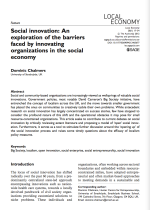 Many governments around the world are exploring ways of shifting the locus of social innovation from a centralized state-led approach to local communities. It makes a lot of sense: It can empower people, utilize local knowledge, create customized solutions and reduce costs. But Dominic Chalmers*, from the University of Strathclyde, argues that this shift would require recognizing some significant barriers.
Many governments around the world are exploring ways of shifting the locus of social innovation from a centralized state-led approach to local communities. It makes a lot of sense: It can empower people, utilize local knowledge, create customized solutions and reduce costs. But Dominic Chalmers*, from the University of Strathclyde, argues that this shift would require recognizing some significant barriers.
Social Innovation Barriers
Chalmers’ review of the literature identifies three main barriers to individuals and organizations engaged in social innovation:
- Protectionism and risk aversion – Chalmers states that a prevailing popular assumption that all people share a common homogenous desire to develop optimal solutions to social problems is a naïve one. His review of the literature highlights competing organizational objectives/logics and how privatization policies can reinforce and extend existing silos/domains rather than bridge them. He also believes that the commissioning agents – governments and philanthropists – are predisposed to conservative decision-making and avoid risks so that they favour incremental rather than disruptive innovation.
- Problem complexity – the work to tackle complex social problems involves cooperation across multi-stakeholder environments. The literature reveals how difficult this work is in practice as existing organizational structures and cultures are just too rigid. The end result is partial solutions that deal with symptoms and not the systemic root causes.
- Networks and collaboration – the literature also highlights the problems for social innovators to make connections to established networks as their issues don’t fit neatly with existing categories.
The net effect, Chalmers warns, may “hasten the ‘fizzling out’” of interest in social innovation and it never realizing its potential.
An Open Innovation Lens
Chalmers argues that these barriers might be overcome by drawing on an “open” paradigm and in particular the study of open innovation (citing writers such as Chesbrough). Researchers have demonstrated how some businesses have benefited from dramatically rethinking their approach to developing new ideas/products. Instead of generating all knowledge in-house, companies that adopt an open innovative approach invest in looking outward, beyond their organizational boundaries, and develop learning networks. Open innovation is also associated with privileging user involvement – directly involving consumers/customers in new solution development. The overall result for some has been radical innovation. Chalmers recognizes that this literature has been largely focused on multinationals and technology companies but believes that it could help to unlock some of the barriers facing social innovation.
Continue reading →

